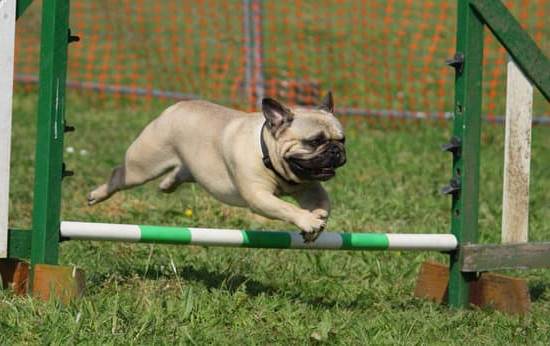Toilet training is a crucial aspect of owning a dog, ensuring cleanliness and convenience for both the pet and the owner. In this article, we will explore the optimal age for toilet training dogs and its importance in their development. By understanding the different stages of canine growth and recognizing signs of readiness, pet owners can establish a strong foundation for successful toilet training.
Additionally, we will cover positive reinforcement techniques, crate training methods, and establishing a consistent potty routine to overcome common challenges in the process. With patience and persistence, you can celebrate the success of toilet training your dog and enjoy the long-term benefits it brings.
Understanding Canine Development
Introduction:
Proper toilet training is essential for dogs, not only to maintain cleanliness and convenience in the household but also to ensure their overall well-being. Understanding the different stages of a dog’s development and how age affects the toilet training process is crucial for successful training. By starting at the optimal age range, pet owners can set their dogs up for success and establish good habits early on.
Age and Toilet Training:
Canine development can be broadly categorized into four stages: neonatal, transitional, socialization, and juvenile. Each stage brings about unique physical and cognitive changes in a dog’s life, which also impact their ability to be toilet trained effectively. It is important to note that there is no one-size-fits-all approach when it comes to determining when a dog should begin toilet training, as individual differences may occur.
The optimal age range for starting toilet training typically falls between 12-16 weeks of age. At this stage, puppies have developed better bladder control and motor skills, making it easier for them to learn where they should eliminate. However, it is important not to rush the process or start too early, as young puppies may still be developing physically and mentally.
| Developmental Stage | Age Range |
|---|---|
| Neonatal | Birth – 2 weeks |
| Transitional | 2 – 4 weeks |
| Socialization | 3 – 14 weeks |
| Juvenile | 3 – 6 months |
During the neonatal and transitional stages, puppies rely on their mother to stimulate them to eliminate by licking their genital area. They are unable to control their bladder or bowel movements independently. As they enter the socialization stage, puppies start developing better coordination and control over their bodily functions, making it an ideal time to introduce toilet training. By the juvenile stage, most dogs have enough physical and cognitive development to fully understand and follow toilet training commands.
Sources:
- Marder AR et al., “Age-related behavior problems in dogs: Steps toward a research model.” Frontiers in Veterinary Science 5 (2018): Article 271.
- The American Society for the Prevention of Cruelty to Animals (ASPCA), “House Training Your Adult Dog or Cat”.
Signs of Readiness
Identifying Behavioral Cues
One of the first steps in toilet training your dog is determining if they are ready for the process. Dogs typically exhibit certain behavioral cues that indicate their readiness for toilet training. One of the most telling signs is when your dog starts sniffing around or circling in a specific area before eliminating.
This behavior shows that they are becoming aware of their need to go to the bathroom and are looking for an appropriate spot. Additionally, if you notice that your dog becomes restless or starts whining or barking when they need to eliminate, it may be a sign that they are ready for toilet training.
Observing Physical Signs
In addition to observing your dog’s behavior, it is important to pay attention to any physical signs that indicate their readiness for toilet training. Some dogs will start displaying visible signs of squatting or sniffing at the ground just before they eliminate.
These can be helpful signals for you to quickly guide them to the designated potty area. Additionally, if your dog manages to hold their bladder or bowels for longer periods and waits until they are taken outside to eliminate, this indicates that they have developed a level of control over their bodily functions and may be ready for toilet training.
Importance of Observation
To accurately determine if your dog is ready for toilet training, it is crucial to diligently observe their habits and routines. Take note of how frequently they eliminate throughout the day and whether there is any consistency in timing or location. By understanding your dog’s natural elimination patterns, you can establish a more effective toilet training routine tailored specifically to them.
It is also important to observe any changes in behavior or patterns as these could be indications of possible health issues that would require veterinary attention. Remember, being attentive and observant towards your dog’s behaviors will greatly contribute to successful toilet training.
Positive Reinforcement Techniques
Positive reinforcement is an essential component in toilet training dogs. By rewarding desired behaviors, you can create a strong foundation and motivate your dog to engage in proper toileting habits. The use of positive reinforcement not only helps your dog learn faster, but it also fosters a positive and enjoyable training experience for both you and your pet.
When it comes to positive reinforcement, the key is to find rewards that genuinely motivate your dog. These rewards can include treats, praise, petting, or playtime with a favorite toy. It’s important to experiment with different types of rewards to determine what resonates most with your furry friend. Finding the right incentive will enhance their willingness to comply with toileting expectations.
Consistency is another crucial factor in building a strong foundation through positive reinforcement. Make sure to reward your dog immediately after they exhibit the desired behavior. This immediate reinforcement helps them connect the action with the reward more effectively. Additionally, consistency in timing and location during toileting routines also promotes learning and understanding for your four-legged companion.
| Reward Type | Description |
|---|---|
| Treats | Small, easily consumable treats that your dog finds highly enticing and delicious. |
| Praise | Verbal affirmations such as “Good job.” or “Well done.” accompanied by enthusiastic tone and body language. |
| Petting | Gentle strokes or scratches behind the ears or on the back as a form of affectionate praise. |
Remember that positive reinforcement should always be paired with patience and consistency. It may take time for your dog to fully grasp the concept of toilet training, so it’s important to remain patient and persistent. Avoid punishment or scolding if accidents occur, as this can create fear and confusion in your pet. A positive attitude and gentle guidance will go a long way in building a strong foundation for successful toilet training.
Crate Training
Crate training is widely recognized as a valuable tool in the process of toilet training dogs. Introducing a crate can help establish a routine and create a designated space for your dog to feel secure, as well as aid in preventing accidents inside the house. By using a crate, you can effectively limit your dog’s access to the rest of the home, giving them fewer opportunities to have accidents and reinforcing the concept of bladder and bowel control.
One of the key benefits of crate training is that it helps dogs develop a natural instinct to keep their living area clean. Dogs are naturally den animals and they prefer not to soil their sleeping area. Through consistent crate training, you can utilize this instinct by ensuring that your dog views their crate as their den or safe space.
To successfully crate train your dog for toilet training, it is important to introduce the crate gradually and positively. Start by making the crate inviting with comfortable bedding and enticing toys or treats inside. Then, slowly introduce your dog into the crate by feeding them their meals near or inside the crate, gradually moving the food closer to the back over time. This process helps your dog associate positive experiences with being in the crate.
During toilet training, it is crucial not to use the crate as punishment for accidents. The purpose of using a crate is not to confine or punish your dog; rather, it serves as an aid in teaching them appropriate bathroom behavior.
Never force your dog into the crate or leave them in there for excessive periods of time. The goal is for your dog to willingly go into their crate and view it as a comfortable space where they can relax.
Establishing a Potty Routine
Toilet training a dog requires consistency and establishing a potty routine is crucial to achieving success. By creating a structured schedule for your furry friend, you can set them up for success and make the process smoother for both of you. In this section, we will provide guidance on how to develop a consistent potty routine for your dog, discuss the importance of regular feeding schedules, and offer tips for recognizing and utilizing natural timing cues.
Developing a consistent potty routine starts with determining the appropriate times to take your dog outside to relieve themselves. It is essential to take them out first thing in the morning, after meals, before bedtime, and periodically throughout the day. By setting specific times for bathroom breaks, you are teaching your dog when it is appropriate and expected to eliminate outside.
In addition to scheduling specific bathroom break times, maintaining regular feeding schedules can greatly assist in establishing a successful potty routine. Dogs typically need to eliminate within 30 minutes after eating, so designating consistent meal times will help predict when they would need to go out. Feeding your dog at set times also regulates their bowel movements, making it easier for you to anticipate when they might need to use the bathroom.
Recognizing and utilizing natural timing cues can further aid in toilet training your dog. Pay attention to your pet’s behavior after waking up from naps or periods of rest as these are often indications that they may need to go outside.
Signs such as sniffing around or circling can also signal that it is time for them to relieve themselves. By observing these cues and promptly taking them outside during these moments, you reinforce the desired behavior of going potty outdoors.
Establishing a potty routine takes time and patience but is vital in setting your dog up for success with toilet training. By implementing a schedule that includes specific bathroom break times, maintaining regular feeding schedules, and recognizing natural timing cues, you can create a routine that aligns with your dog’s natural habits.
Consistency is key in reinforcing good potty behavior, and a structured routine will help your furry friend understand what is expected of them when it comes to bathroom etiquette.
Common Toilet Training Challenges
Toilet training can sometimes present challenges for dog owners, but with the right approach and problem-solving strategies, these challenges can be overcome. In this section, we will address some common issues that may arise during the toilet training process and offer solutions to help troubleshoot these difficulties.
One of the most common challenges that dog owners might encounter is accidents occurring inside the house even after what seemed like successful toilet training. Accidents can happen for various reasons including poor supervision, insufficiently frequent bathroom breaks, or even a medical condition such as a urinary tract infection.
To address this issue, it’s important to reinforce a consistent schedule of potty breaks throughout the day to minimize accidents. Additionally, keeping a close eye on your dog and providing ample opportunities for them to relieve themselves outside can significantly reduce indoor accidents.
Another challenge that may occur during toilet training is marking behavior. Marking is when dogs urinate in small amounts in various spots throughout the house to claim territory. While this behavior is more common in unneutered male dogs, female dogs can also display marking behavior. To tackle this issue, consider having your dog neutered or spayed if they are not already. Additionally, reinforcing consistent and clear boundaries within the home through positive reinforcement techniques can help discourage marking behaviors.
Sometimes dogs may regress in their toilet training progress after showing initial signs of success. This regression can be due to factors such as change in routine or environment, stress or anxiety, or illness.
If your dog regresses in their toilet training habits, it’s important not to get discouraged but instead identify any changes that might have triggered the regression and address them accordingly. By going back to basics with consistent routines and positive reinforcement techniques, you can help your dog regain their previous progress and continue forward with successful toilet training.
Remember that each dog is unique and may face different challenges during toilet training. It’s essential to approach these challenges with patience and understanding while consistently reinforcing positive behavior. By troubleshooting these common issues and tailoring your approach to your dog’s individual needs, you can overcome toilet training challenges and achieve a successful outcome.
Patience and Persistence
Maintaining a positive attitude is crucial when it comes to toilet training your dog. It is important to remember that accidents will happen, setbacks may occur, and each dog learns at their own pace. By remaining patient and persistent, you can help create a positive and stress-free environment for both you and your furry friend.
One of the key aspects of maintaining a positive attitude is to celebrate small successes along the way. Every time your dog successfully uses the designated potty area or holds their bladder for longer periods, make sure to praise and reward them. This positive reinforcement helps to reinforce the desired behavior and motivates your dog to continue their progress.
In addition, it is essential to set realistic expectations and be prepared for setbacks. Dogs are individuals with different personalities and learning styles. Some dogs may pick up toilet training quickly, while others may take longer to grasp the concept. By understanding this, you can avoid getting frustrated or discouraged during the process.
Here are some tips for maintaining a positive attitude during toilet training
- Stay calm: Dogs can sense when we are stressed or frustrated, which can impede their progress. Take deep breaths and remain calm throughout the training sessions.
- Focus on progress: Instead of dwelling on accidents or setbacks, focus on the progress your dog has made so far. Recognize even the smallest improvements as steps in the right direction.
- Be consistent: Consistency is key when it comes to toilet training. Stick to your established routine and training methods without wavering. A consistent approach will help your dog understand what is expected of them.
- Take breaks if needed: If you feel overwhelmed or frustrated, take short breaks from the training process. Use these breaks as an opportunity to recharge yourself mentally so that you can come back with a positive mindset.
Remember, toilet training is a journey that requires time and patience. Keeping a positive attitude will not only benefit your dog but also make the process more enjoyable for you.
Conclusion
In conclusion, toilet training is an essential aspect of owning a dog. Throughout this article, we have explored the importance of proper toilet training, the optimal age range for starting the training process, and how to determine if your dog is ready for toilet training. We have also discussed positive reinforcement techniques, crate training, establishing a potty routine, troubleshooting common challenges, and the need for patience and persistence in the training process.
Now that you understand the fundamentals of toilet training and have implemented these strategies with your dog, it is time to celebrate your success. Toilet training requires commitment and consistency, so achieving this milestone is certainly something to be proud of. Take a moment to appreciate the accomplishment of having a well-trained dog who can effectively use designated areas for toileting.
The benefits of having a toilet trained dog are numerous. Not only will it ensure cleanliness in your home and eliminate indoor accidents, but it will also provide convenience and peace of mind. You will no longer need to worry about constantly cleaning up messes or dealing with unpleasant odors. Instead, you can enjoy the company of your furry friend without any hiccups caused by toileting issues.
Remember that effective toilet training requires ongoing effort. While accidents may occur occasionally even after successful training, maintaining a positive attitude is key. Continue to reinforce good behavior through rewards and praise, as these positive experiences will further strengthen your bond with your dog.
By implementing the strategies outlined in this article and remaining patient and persistent in your efforts, you can fully enjoy the long-term benefits and rewards that come with having a well-trained dog-cleanliness, convenience, peace of mind-and create an environment where both you and your four-legged companion can thrive together.
Frequently Asked Questions
At what age are dogs easiest to potty train?
Dogs are generally easiest to potty train between the ages of 8 and 12 weeks old. During this period, puppies are more receptive to learning, and their cognitive abilities and physical control have developed enough for them to start understanding the concept of where and when to eliminate waste.
It is crucial to provide consistent positive reinforcement during this stage to establish good habits.
At what age should a puppy be toilet?
A puppy should be toilet trained as early as possible, typically within the first few months of its life. The exact age can vary depending on the individual puppy’s development, but most experts recommend starting the process around 12-16 weeks old.
By this time, puppies have improved bladder control and can hold their urine for longer periods. Consistency, patience, and a well-established routine are key factors in successfully toilet training a puppy at this age.
What dog breeds are hardest to potty train?
While it’s important to note that each dog is unique and capable of being potty trained with the right approach, some breeds may present more challenges during this process compared to others. Certain small or toy breeds like Chihuahuas and Dachshunds are often mentioned as being harder to potty train due to their stubbornness and independent nature.
Additionally, some terrier breeds known for their strong willpower can also pose difficulties during training. However, it’s important to remember that every dog is an individual; proper training techniques, consistency, patience, and positive reinforcement can help overcome any breed-related challenges in potty training a dog.

Welcome to the blog! I am a professional dog trainer and have been working with dogs for many years. In this blog, I will be discussing various topics related to dog training, including tips, tricks, and advice. I hope you find this information helpful and informative. Thanks for reading!





